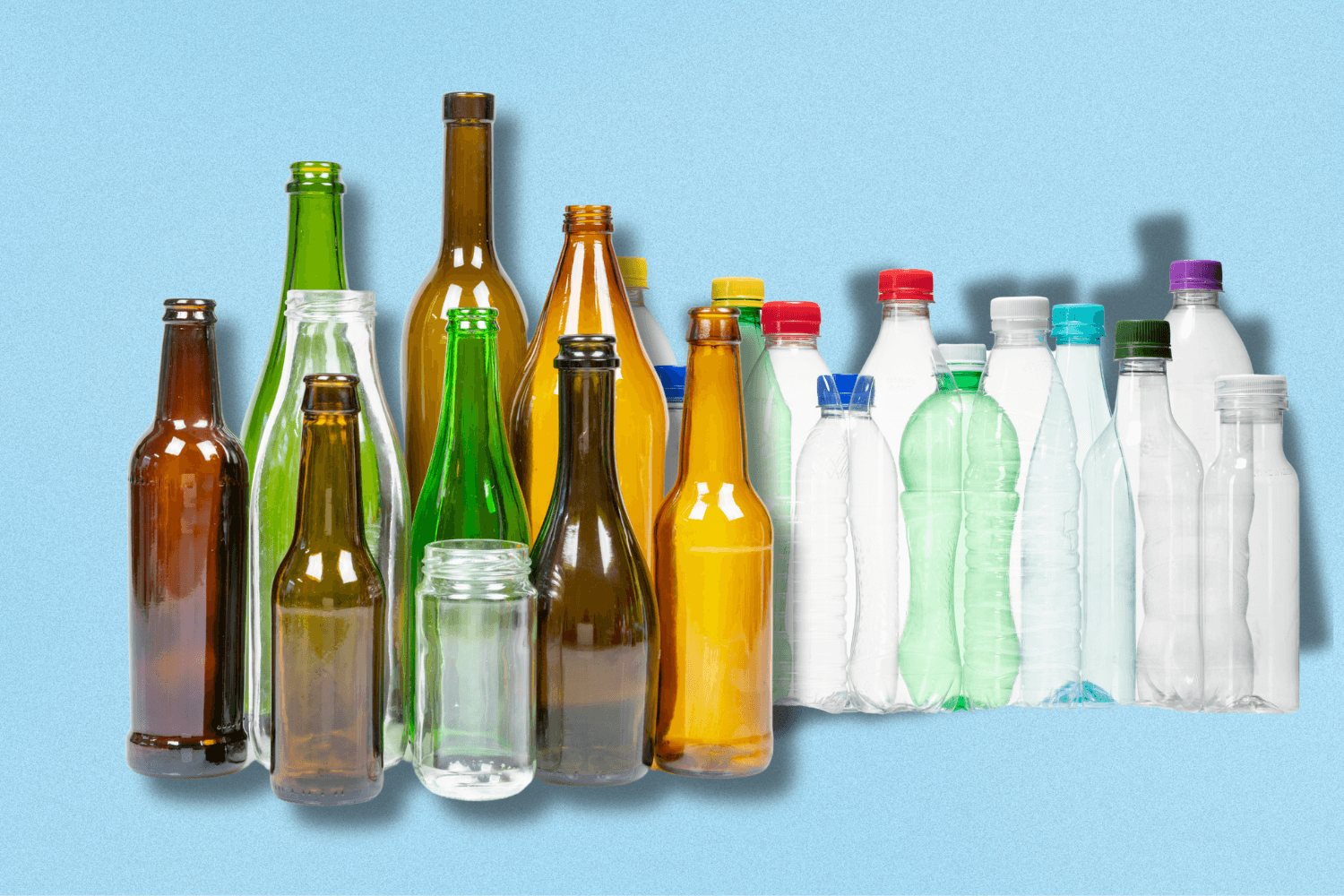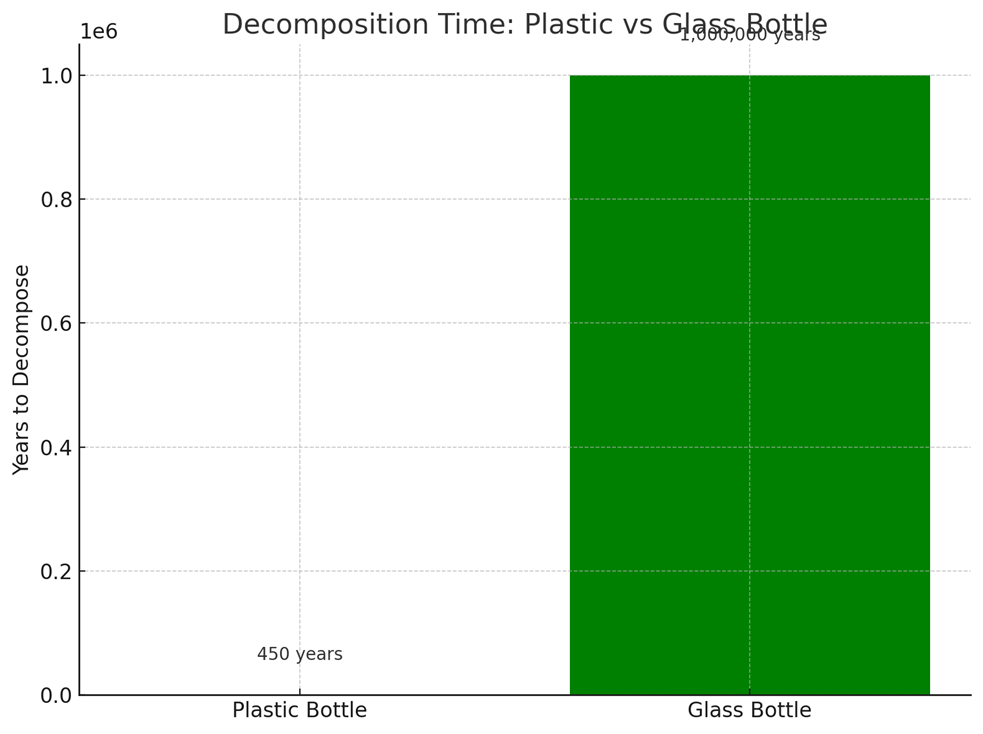Eco Friendly
Why a Glass Bottle Beats a Plastic Bottle for You and the Planet 🧴🌏

Ever bought a plastic bottle of water thinking, “It’s just one, no biggie”?
Well, mate — that “one” might still be hanging around when your great-great-grandkids are flying electric utes on Mars.
Let’s talk about the real impact of plastic bottles, why glass is the smarter swap, and take a quick trip with our mate, Plastico the Bottle, to see what his life looks like after you toss him in the bin.
🗓️ The Big Difference: Lifespan on Earth (and Beyond)
Let’s start with the shocking bit — decomposition time.

(See chart above)
| Material | Time to Decompose in Nature |
| Plastic Bottle | 450 years (minimum) |
| Glass Bottle | Up to 1,000,000 years* |
🧨 And no — that’s not a typo.
*Glass technically doesn’t decompose. It just breaks into smaller pieces. Unless it’s recycled, it’ll sit there forever looking smug.
🧪 What’s Plastic Doing While It Waits?
While glass chills in the landfill, plastic gets busy — and not in a good way.
- Breaks down into microplastics, which enter the food chain.
- Releases toxic chemicals like BPA and phthalates.
- Ends up in oceans, clogging coral reefs and fish bellies.
- Gets mistaken for food by turtles, seabirds, and whales.
🥤 In 2022, Australians used over 373 million plastic bottles per year. Less than 30% were recycled.
(Source: Clean Up Australia)
🐢 A Day in the Life of Plastico the Bottle
Let’s say hello to Plastico — a bright blue water bottle chucked in a park bin in Melbourne.
9:15 AM:
Thrown away after a jog near Albert Park Lake. Should’ve gone in a recycle bin — but nope.
2:30 PM:
Wind blows him out. He’s now rolling along St Kilda Road like a tumbleweed on a mission.
5:45 PM:
He slips into the Yarra River. “This is kinda nice,” he thinks.
Day 3:
Spotted by a duck. Not food? Disappointing.
Week 6:
Drifting into Port Phillip Bay. Sunlight starts breaking him into microplastics. Lovely.
Year 4:
He’s now invisible to the eye, but still present in fish, shellfish, and that fancy sea salt on your sourdough toast.
Year 150:
His chemicals are now literally everywhere. From your water bottle to a wombat’s nose.
Year 450:
Still not gone.
🍃 Why Glass Is a Better Mate (for You and the Planet)
Glass might be heavier and more fragile, but it’s honest and clean — like a good mate who tells it like it is.
✅ Non-Toxic and Safe
- Glass doesn’t leach chemicals into your water.
- No BPA, no hormone disruptors, no plastic taste.
♻️ Infinitely Recyclable
- Can be recycled over and over without losing quality.
- In Australia, glass recycling rates are over 55% and rising.
🔥 Withstands Heat and UV
- Great for sterilising or reusing.
- Plastic gets cranky in heat — it warps, leaks, and sheds toxins.
🌿 Doesn’t Pollute Wildlife
- Glass, if broken, turns into sand-like particles over centuries.
- Doesn’t float, so doesn’t usually end up in whales or reef systems.
🧪 Health Impact: Plastic vs Glass
| Feature | Plastic Bottle | Glass Bottle |
| BPA / Chemical Risk | High (if reused) | None |
| Taste of Contents | May absorb odours | Pure and neutral |
| UV Exposure | Can degrade | UV-resistant |
| Safe for Hot Liquids | Often unsafe | Yes |
You wouldn’t drink from a kettle made of cling film, so why sip from hot plastic?
🇦🇺 How Australia’s Tackling the Plastic Problem
Melbourne and Perth councils are already pushing hard to go plastic-free.
- Victoria has banned single-use plastics including cutlery and polystyrene (2023).
- WA led the charge, phasing out single-use plastics across retailers.
- Container deposit schemes in both states pay 10 cents per bottle returned.
(Source: EPA Victoria and WA Government Waste Plan)
♻️ But for glass to work, we need people to choose it in the first place.
🤔 The Common Excuses for Choosing Plastic (and Better Comebacks)
“It’s cheaper.”
True short-term. But the long-term cost to your health and environment? Huge.
“Glass breaks.”
Fair — but many modern bottles are shock-resistant or silicone-wrapped.
“Plastic is lightweight.”
So are the consequences — until you’re eating microplastic prawns.
“I recycle my plastic.”
Good on you! But globally, only 9% of plastic ever made has been recycled.
(Source: UNEP Report 2022)
📆 Lifespan Timeline: Plastic vs Glass
| Year | Plastic Bottle | Glass Bottle |
| 1 | Might already leach toxins | Still clean as a whistle |
| 10 | Breaking into microplastics | Probably recycled |
| 100 | Floating in the Indian Ocean | Recycled into a candle holder |
| 450 | Still in landfill, harming life | Still recyclable |
| 1M+ | Maybe gone. Maybe not. | Still kicking, mate |
✅ The 5-Step Eco-Swap Challenge (Glass vs Plastic)
You’ve read the facts. Now here’s your challenge:
- Ditch single-use plastic bottles
Carry a glass or stainless steel bottle with pride.
- Stock the office fridge with glass
Swap that plastic water delivery for glass-sourced brands.
- Use glass jars for food storage
It’s better for leftovers, looks better, and saves money.
- Educate your mates
Share a post, run a workshop, or just chuck the stat into pub chat.
- Support local glass recycling
Buy from Aussie businesses that use reclaimed glass in their packaging.
🥂 Final Thought: Raise a Glass (Not Plastic)
At the end of the day, it’s about small swaps that add up big time.
Your humble drink bottle has the power to either harm the planet for 450+ years — or be part of a clean, reusable cycle.
So next time you’re reaching for a drink in Melbourne or Perth, remember:
Glass might be heavier in your hand — but it leaves a lighter footprint behind.
Sources:
- Clean Up Australia
- UN Environment Programme Report 2022
- EPA Victoria – Plastic Waste Policy
- WA Government – Plan for Plastics
- Planet Ark – Glass Recycling
